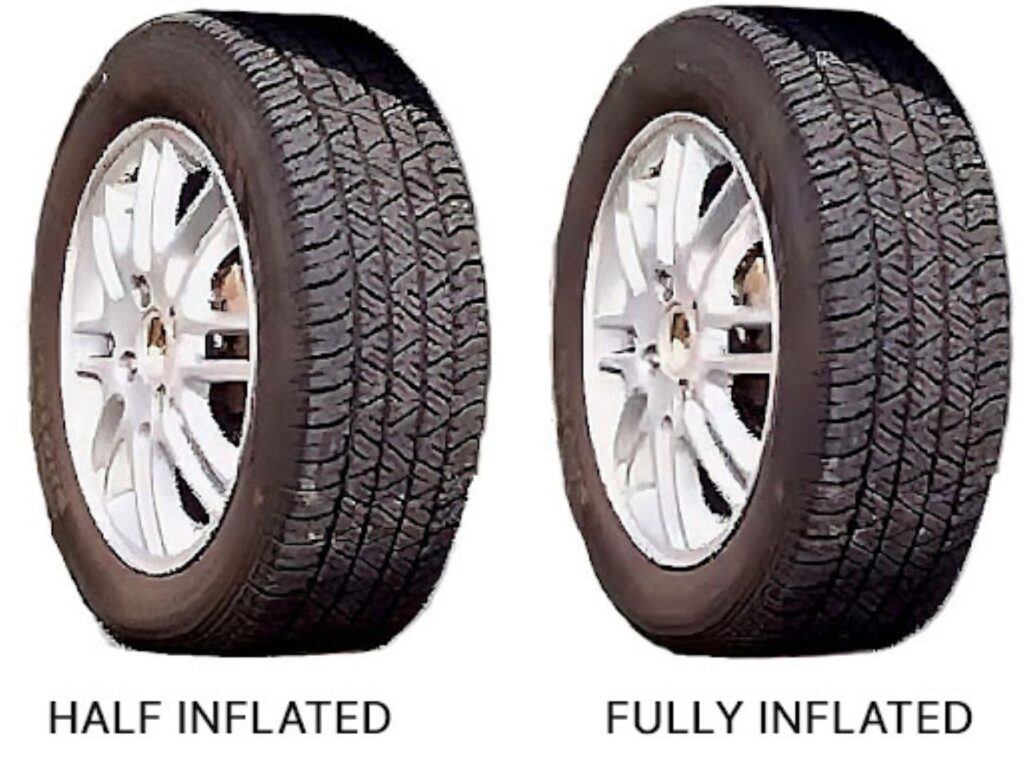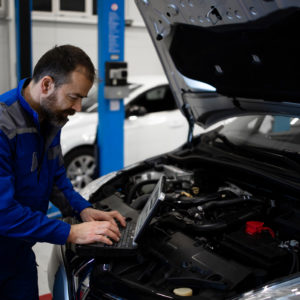Tire pressure affects your car’s fuel economy, its handling, and the lifespan of its wheels. It’s important to keep the pressure at the manufacturer-recommended level by inflating the tires whenever they look deflated or when the low tire pressure light activates.
However, there are situations when you need to drive on tires with low pressure. In those emergencies, what tire pressure is too low to drive on?
What Tire Pressure Is Too Low For Safe Driving?
20 pounds per square inch (psi) is the minimum tire pressure that you can conceivably continue to drive your car on. If the pressure drops below even that, the tire should be considered flat.

Driving on 20 psi tire pressure is not something you should do and is not recommended except in an emergency. Tires constantly lose air, which causes pressure to drop, and driving hastens the process of air loss.
As soon as possible, inflate the affected tires back to the safer pressure level shown on the vehicle’s tire information decal.
What Is The Recommended Tire Pressure?
In general, it’s advised to maintain tire pressure between 32 and 36 psi, but this value may vary depending on the vehicle. This pressure range keeps the tires firm enough to support your car’s weight while avoiding straining the materials that make up the tire.

How Does Temperature Affect Tire Pressure?
Have you ever gone to bed knowing that your car’s tire pressure was fine and woken up to find it had either drastically dropped or risen? That’s because the temperature outside the tires can change the tire pressure. Every 10 degrees Fahrenheit of temperature change will alter the pressure by one psi.
Rising temperatures will make air expand in volume. Heated air exerts more force against the tire’s interior, which translates to increased tire pressure.
Conversely, temperature drops will cause air to contract. This reduces tire pressure.
Whenever you measure tire pressure, check the temperature outside your car. If it gets hotter or colder, the pressure levels inside the tires will change accordingly. In hot weather, tires with low pressure might seem fine.
Why Should You Avoid Driving With Low Tire Pressure?
It’s not recommended to drive your car if the tire pressure is too low. Otherwise, the following issues can take place:
Tire Blowout
Underinflated tires can blow out while driving at higher speeds. The sidewalls of tires with low air pressure flex more often, making their interior hotter. If the interior gets too hot, part of the tire’s rubber can violently separate from it. The ensuing blowout can cause you to lose control of your car.
Reduced Fuel Economy
Driving with low tire pressure increases the fuel consumed by your car. Low air pressure makes the tires softer and less capable of rolling. The engine needs to work harder to rotate soft tires, so it burns more fuel to produce more power.
Degraded Handling
When an underinflated tire’s sidewall flexes, its tread also writhes. Since the tread serves as the point of contact between the tire and the road surface, its writhing reduces the tire’s stability and traction. Tires with low air pressure respond more slowly and clumsily to inputs from the steering wheel and your car needs more room to brake itself.
Shorter Tire Service Life
Tires with insufficient air pressure have shorter service lives. Low tire pressure warps the tire’s footprint, making its inner and outer shoulders wear out faster. You will have to replace the prematurely worn-out tire before it causes even more problems.
While it’s possible to drive with low tire pressure, you should only do so in an emergency. Try to inflate the tires as soon as possible.
Negative Environmental Impact
Underinflated tires cause the engine to burn more fuel because the vehicle requires more power to move. As a result, increased fuel consumption occurs.
Also, underinflated tires wear out faster than regularly inflated tires, so the rate at which they’re dumped at landfills is much faster.
Ensuring that your tires have the right air pressure might not be as urgent as resolving complex engine issues, especially when the pressure’s off by only a few figures.
Still, it pays to have your tires inflated with the right amount of air pressure, as it helps with road safety, optimal tire performance, prolonged tread life, fuel economy, and overall handling, cornering, and steering performance.
Ensure Your Tires Are Properly Inflated with These Tips
Here are some things you can do to maintain your tires’ prescribed air pressure:
Carry a Portable Air Gauge
First, it pays to have an accurate air gauge stored in your trunk. There’s a possibility for air meters in service stations to give out inaccurate readings due to wear, so having your own gauge can ensure that you’re getting the right numbers.
Inflate Your Tires Slowly
Filling up your tires slowly is another great tip to keep in mind. Remember that overinflation is as bad as underinflation, so be sure to slow down when you’re getting close to the required psi level.
Replace the Valve Stem Caps as Needed
After refilling your tires, it’s a good idea to replace the valve stem caps, especially when they’re worn out. This will ensure that air won’t leak out of the tires as you drive.
Any information provided on this Website is for informational purposes only and is not intended to replace consultation with a professional mechanic. The accuracy and timeliness of the information may change from the time of publication.

































